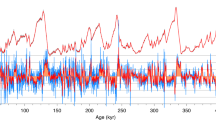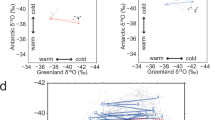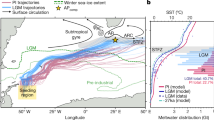Abstract
RECENT geochemical data1,2 have challenged the view that rapid climate fluctuations in the North Atlantic at the end of the last glacial were caused by the thermohaline circulation of the ocean being switched 'on' or 'off'. Instead, these data suggest that the circulation pattern must have switched between a warm, deep mode and a cold, shallow mode, probably associated with different sites of deep convection3. Here I present simulations with a three-dimensional ocean model, coupled to an idealized atmosphere, which show this kind of transition. The mechanism for the transition is a rearrangement of convection in the North Atlantic, triggered by a brief freshwater pulse. This results in a drop in sea surface temperature in the North Atlantic by up to 5 °C within less than 10 years. The rate of North Atlantic Deep Water (NADW) forma-tion is the same in the cold climate as in the warm climate, but NADW sinks to intermediate depths only, while Antarctic Bottom Water pushes north to fill the entire abyssal Atlantic.
This is a preview of subscription content, access via your institution
Access options
Subscribe to this journal
Receive 51 print issues and online access
$199.00 per year
only $3.90 per issue
Buy this article
- Purchase on Springer Link
- Instant access to full article PDF
Prices may be subject to local taxes which are calculated during checkout
Similar content being viewed by others
References
Veum, T. et al. Nature 356, 783–785 (1992).
Lehman, S. J. & Keigwin, L. D. Nature 356, 757–762 (1992).
Zahn, R. Nature 356, 744–746 (1992).
Boyle, E. A. & Keigwin, L. Nature 330, 35–40 (1987).
Keigwin, L. D. et al. J. geophys. Res. 96, 16811–16826 (1991).
Trenberth, K. E. & Solomon, A. Clim. Dyn. 10, 107–134 (1994).
Levitus, S. Climatological Atlas of the World Ocean (US Dept of Commerce, NOAA, Washington DC, 1982).
Manabe, S. & Stouffer, R. J. J. Clim. 1, 841–866 (1988).
Maier-Reimer, W. & Mikolajewicz, U. in Oceanography (eds Ayala-Castan̄ares, A., Wooster, W. & Yán̄ez-Arancibia, A.) 87–100 (UNAM, México, 1989).
Marotzke, J. & Willebrand, J. J. phys. Oceanogr. 21, 1372–1385 (1991).
Haney, R. L. J. phys. Oceanogr. 1, 241–248 (1971).
Rahmstorf, S. & Willebrand, J. J. phys. Oceanogr. (in the press).
Sarnthein, M. et al. Paleoceanography 9, 209–267 (1994).
Kushnir, Y. J. Clim. 7, 142–157 (1994).
Rahmstorf, S. J. Clim. (in the press).
Stommel, H. Tellus 13, 224–230 (1961).
Welander, P. Dyn. Atmos. Oceans 6, 233–242 (1982).
Lenderink, G. & Haarsma, R. J. J. phys. Oceanogr. 24, 1480–1493 (1994).
Fairbanks, R. G. Nature 342, 637–642 (1989).
Weaver, A. J. & Hughes, T. M. C. Nature 367, 447–450 (1994).
Send, U. & Marshall, J. J. phys. Oceanogr. (in the press).
Lehman, S. J. & Keigwin, L. D. Nature 358, 197–198 (1992).
Author information
Authors and Affiliations
Rights and permissions
About this article
Cite this article
Rahmstorf, S. Rapid climate transitions in a coupled ocean–atmosphere model. Nature 372, 82–85 (1994). https://doi.org/10.1038/372082a0
Received:
Accepted:
Issue Date:
DOI: https://doi.org/10.1038/372082a0
This article is cited by
-
Iberian Margin surface ocean cooling led freshening during Marine Isotope Stage 6 abrupt cooling events
Nature Communications (2023)
-
The Rapidly Changing Arctic and Its Impact on Global Climate
Journal of Ocean University of China (2019)
-
Fram Strait sea ice export affected by thinning: comparing high-resolution simulations and observations
Climate Dynamics (2019)
-
Sedimentary Characteristics of the Second Marine Layer During the Late Marine Isotope Stage 3 in Southern Yellow Sea and Their Response to the East Asian Monsoon
Journal of Ocean University of China (2018)
-
The sensitivity of the Atlantic meridional overturning circulation to enhanced freshwater discharge along the entire, eastern and western coast of Greenland
Climate Dynamics (2016)
Comments
By submitting a comment you agree to abide by our Terms and Community Guidelines. If you find something abusive or that does not comply with our terms or guidelines please flag it as inappropriate.



